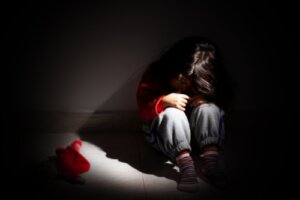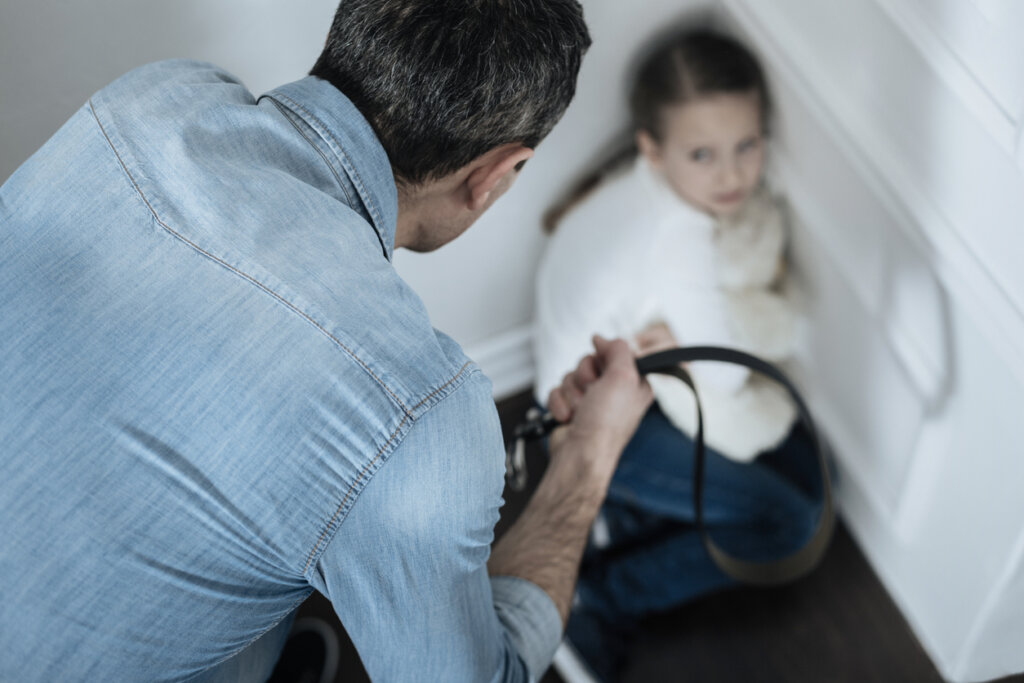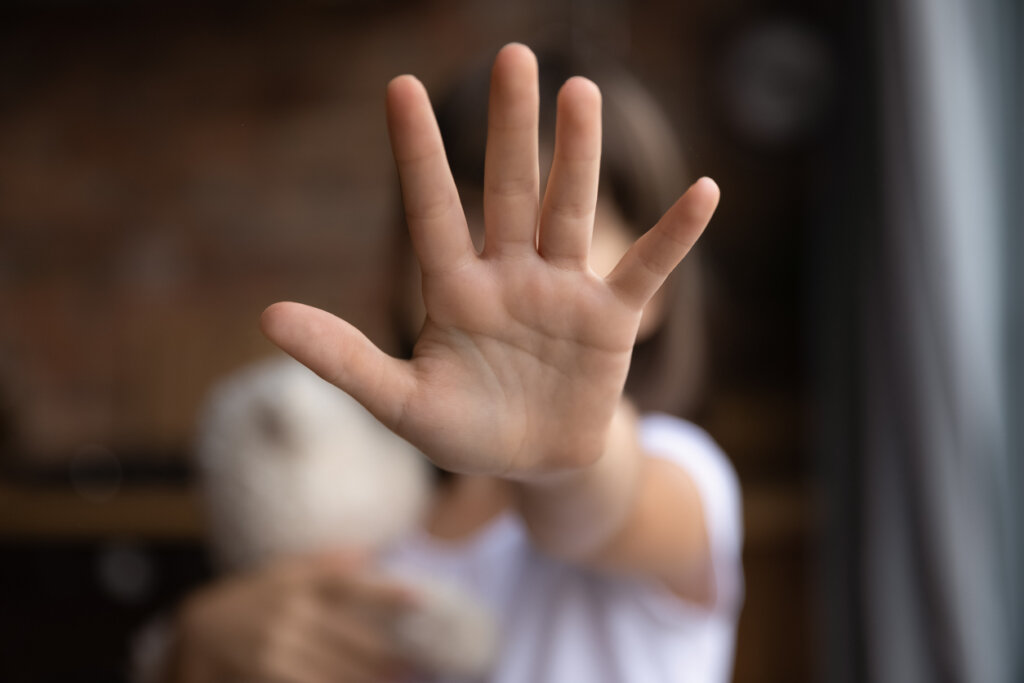The Link Between Child Abuse Syndrome and Impulsivity


Written and verified by the psychologist Gorka Jiménez Pajares
Child abuse syndrome (CAS) consists of a series of symptoms that emerge in the child who’s the victim of violent behavior. As a rule, it’s perpetrated by people who are important to them. It represents a multifactorial and multicultural picture. In fact, it’s one of the greatest challenges that we face as a society today. Moreover, violence or negligence exercised during childhood is usually hidden, denied, or ignored.
Abusers tend to be individuals with high levels of impulsivity. Consequently, they only have to face the smallest of provocations to react in the worst and most violent of ways. As a result of the abuse, the child’s mind becomes deformed, spoiled, and impoverished, suggesting a future with no hope. However, before delving any deeper into child abuse syndrome, we’re going to explore impulsivity.
“Impulsivity is like a drug: the more you use it, the more you need to get the same effect.”
-Roy Baumeister-
Impulsivity
Experts have defined impulsiveness from different perspectives. According to the psychologist, Cristina Arias (Arias et al., 2021), it corresponds to the ‘reaction to a stimulus, carried out without planning’.
Therefore, the individual doesn’t take into account the repercussions or the impact of their way of responding. In addition, behaviors that gravitate toward impulsiveness are often short-lived with potentially unpleasant consequences.
“Impulsivity is the inability to resist an impulse, emotion, or temptation, even when we know it is harmful.”
-John Ratey-

Negative urgency, the starting point of impulsiveness
The perception of urgency is the incombustible and apparently indomitable engine that triggers impulsive or hasty behavior. In this context, urgency is clothed in negative emotions such as anguish, irritability, or fury. It precipitates certain behavioral reactions. In the area of child abuse, they can be devastating, desperate, and even fatal.
Impulsivity could be conceived as the absence of the ability to inhibit a response or a reaction arising from an impulse. For example, take the case of Andrew, aged 24. He says that when he’s walking along the street and sees a piece of clothing he likes, he’s unable to stop his impulse to buy it. This is despite the fact that he can’t afford it.
Andrew is unable to refrain from his impulse. Therefore, without considering the consequences (in this case the debt he’ll incur), he makes the purchase. In effect, he’s succumbed to the ‘perception of urgency’.
“Negative urgency can make you feel like you don’t have a choice, but there is always a choice.”
-Judith Orloff-
Child abuse syndrome: between life and death
It was around the time of the Second World War that health professionals first coined the term battered child syndrome. Indeed, these experts, largely in the fields of pediatrics and radiology started to use the term due to the increasing number of distressing cases they saw.
During the decades after the war, this term was widely used to describe events in which caregivers physically abused minors.
Subsequently, other forms of violence (for example, psychological violence) were included and the name of the syndrome was changed. This gave rise to what’s now known as child abuse syndrome (Tsranchev et al., 2022). Its characteristics and manifestations are clear and multiple. For instance, they might be on a physical level like fractures, bruises, and bites. Alternatively, on a psychological level like post-traumatic stress, language problems, and personality disorders.
“Child abuse is a form of violence that leaves invisible scars on the minds and hearts of children.”
-Alice Miller-

Child abuse: a potentially deadly form of violence
According to research published in Folia Medica, the worst outcome of child abuse is the death of the child. Moreover, in these cases of homicidal child violence, impulsivity plays an even more important role (Tsranchev et al., 2022). Fortunately, they’re less frequent than other forms of abuse.
The individuals who commit these atrocities exercise the abuse with particularly explosive and voracious fury. In fact, impulsiveness plays a predominant role. The perpetrator carries out multiple behaviors. According to Dr. Ivan Tsranchev, from the Department of Forensic Medicine at the Bulgarian University of Plovdiv, these might involve:
- Throwing the child against any hard surface.
- Multiple impacts to the child’s body are applied with great force for a short period.
- A process of sudden acceleration or deceleration of the whole body.
Unfortunately, child abuse syndrome prevails in the public arena. Its consequences are disturbing, unfortunate, and heartbreaking. If the child survives, they may face serious consequences. For instance, post-traumatic stress disorder or borderline personality disorder.
As you can see, impulsivity plays a crucial role in abusive behaviors. Faced with trivial or minor stimuli, the adult reacts without taking into account the repercussions of their behavior. Sadly, these consequences have the potential to unleash a burning hell that puts an end to the infant’s future.
“Child abuse is often the result of impulsive violent behavior with minimal provocation, which can be fatal.”
-Ivan Tsranchev-
Child abuse syndrome (CAS) consists of a series of symptoms that emerge in the child who’s the victim of violent behavior. As a rule, it’s perpetrated by people who are important to them. It represents a multifactorial and multicultural picture. In fact, it’s one of the greatest challenges that we face as a society today. Moreover, violence or negligence exercised during childhood is usually hidden, denied, or ignored.
Abusers tend to be individuals with high levels of impulsivity. Consequently, they only have to face the smallest of provocations to react in the worst and most violent of ways. As a result of the abuse, the child’s mind becomes deformed, spoiled, and impoverished, suggesting a future with no hope. However, before delving any deeper into child abuse syndrome, we’re going to explore impulsivity.
“Impulsivity is like a drug: the more you use it, the more you need to get the same effect.”
-Roy Baumeister-
Impulsivity
Experts have defined impulsiveness from different perspectives. According to the psychologist, Cristina Arias (Arias et al., 2021), it corresponds to the ‘reaction to a stimulus, carried out without planning’.
Therefore, the individual doesn’t take into account the repercussions or the impact of their way of responding. In addition, behaviors that gravitate toward impulsiveness are often short-lived with potentially unpleasant consequences.
“Impulsivity is the inability to resist an impulse, emotion, or temptation, even when we know it is harmful.”
-John Ratey-

Negative urgency, the starting point of impulsiveness
The perception of urgency is the incombustible and apparently indomitable engine that triggers impulsive or hasty behavior. In this context, urgency is clothed in negative emotions such as anguish, irritability, or fury. It precipitates certain behavioral reactions. In the area of child abuse, they can be devastating, desperate, and even fatal.
Impulsivity could be conceived as the absence of the ability to inhibit a response or a reaction arising from an impulse. For example, take the case of Andrew, aged 24. He says that when he’s walking along the street and sees a piece of clothing he likes, he’s unable to stop his impulse to buy it. This is despite the fact that he can’t afford it.
Andrew is unable to refrain from his impulse. Therefore, without considering the consequences (in this case the debt he’ll incur), he makes the purchase. In effect, he’s succumbed to the ‘perception of urgency’.
“Negative urgency can make you feel like you don’t have a choice, but there is always a choice.”
-Judith Orloff-
Child abuse syndrome: between life and death
It was around the time of the Second World War that health professionals first coined the term battered child syndrome. Indeed, these experts, largely in the fields of pediatrics and radiology started to use the term due to the increasing number of distressing cases they saw.
During the decades after the war, this term was widely used to describe events in which caregivers physically abused minors.
Subsequently, other forms of violence (for example, psychological violence) were included and the name of the syndrome was changed. This gave rise to what’s now known as child abuse syndrome (Tsranchev et al., 2022). Its characteristics and manifestations are clear and multiple. For instance, they might be on a physical level like fractures, bruises, and bites. Alternatively, on a psychological level like post-traumatic stress, language problems, and personality disorders.
“Child abuse is a form of violence that leaves invisible scars on the minds and hearts of children.”
-Alice Miller-

Child abuse: a potentially deadly form of violence
According to research published in Folia Medica, the worst outcome of child abuse is the death of the child. Moreover, in these cases of homicidal child violence, impulsivity plays an even more important role (Tsranchev et al., 2022). Fortunately, they’re less frequent than other forms of abuse.
The individuals who commit these atrocities exercise the abuse with particularly explosive and voracious fury. In fact, impulsiveness plays a predominant role. The perpetrator carries out multiple behaviors. According to Dr. Ivan Tsranchev, from the Department of Forensic Medicine at the Bulgarian University of Plovdiv, these might involve:
- Throwing the child against any hard surface.
- Multiple impacts to the child’s body are applied with great force for a short period.
- A process of sudden acceleration or deceleration of the whole body.
Unfortunately, child abuse syndrome prevails in the public arena. Its consequences are disturbing, unfortunate, and heartbreaking. If the child survives, they may face serious consequences. For instance, post-traumatic stress disorder or borderline personality disorder.
As you can see, impulsivity plays a crucial role in abusive behaviors. Faced with trivial or minor stimuli, the adult reacts without taking into account the repercussions of their behavior. Sadly, these consequences have the potential to unleash a burning hell that puts an end to the infant’s future.
“Child abuse is often the result of impulsive violent behavior with minimal provocation, which can be fatal.”
-Ivan Tsranchev-
All cited sources were thoroughly reviewed by our team to ensure their quality, reliability, currency, and validity. The bibliography of this article was considered reliable and of academic or scientific accuracy.
-
Arias Galarza, C. P., Chávez Prado, S. O., Cisneros Jumbo, J. S., Moscoso Salazar, J., Piedra Vázquez, P. (2021). Maltrato infantil e impulsividad: un estudio de adolescentes en acogimiento institucional en Ecuador. Universidad Internacional SEK. https://repositorio.uisek.edu.ec/handle/123456789/4493
- Forero, L.C.A., Araújo Reyes, A.P., Godoy Díaz, A.P., Vera Rueda, M.E. (2010). Maltrato infantil y sus consecuencias a largo plazo. MedUNAB [Internet], 13(2), 103-15. Consultado en abril de 2023. https://revistas.unab.edu.co/index.php/medunab/article/view/1155
- Manso, J. M. M. (2005). Estudio sobre las consecuencias del maltrato infantil en el desarrollo del lenguaje. Anales de Psicología/Annals of Psychology, 21(2), 224-230. https://revistas.um.es/analesps/article/view/26821
- Tsranchev I, Timonov P, Spasov S, Dobrev T, Yancheva S, Gulinac M, Fasova A. (2022). Child abuse syndrome – a forensic case of fatal impulsive act of violence. Folia Med (Plovdiv), 64(5), 834-839. https://foliamedica.bg/articles.php?id=67042
This text is provided for informational purposes only and does not replace consultation with a professional. If in doubt, consult your specialist.







